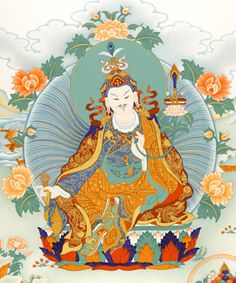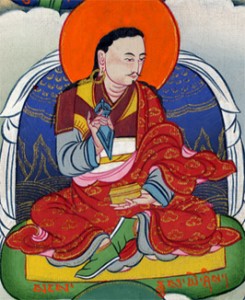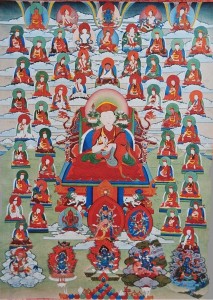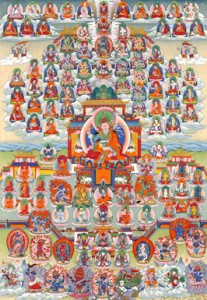Barway Dorje Lineage and Barom Kagyu Lineage – Part I
[From a teaching by Bardor Tulku Rinpoche given in Arizona in January 2010. Translated by Lama Yeshe Gyamtso. Transcribed by Liz Summers and edited by Basia Coulter.]
I have been asked to speak about the lineage and the treasures of Terchen Barway Dorje and of the treasure tradition in general, and I have consented to do so.

I have allowed a little bit of printed information about Terchen Barway Dorje to be circulated, but I have never spoken one word about my predecessor in a public setting. It is not because I am ignorant of Terchen Barway Dorje’s life or of his teachings, or that I have failed to understand their true meaning or the nature of things. It is out of respect and devotion for my root guru, the Sixteenth Gyalwang Karmapa, that I have sought in all of my teaching and traveling only to serve his activity and his teachings. I have, therefore, been extremely careful to abstain from anything that could by any stretch of the imagination be conceived as self-aggrandizement or self-promotion.
It is not that I do not know about Terchen Barway Dorje. I was born in Tibet, a country filled with dharma; I was recognized at a very early age as a nirmanakaya. Like any nirmanakaya, I am supposed to have been born with special qualities—this is something that is recognized in our tradition. There are two kinds of qualities that people can have: There are those [qualities], which come through training in any given life and there are those that are the result of previous lives. Any nirmanakaya is supposed to be born with an innate recognition of the nature of all things. And indeed we see that the great masters, such as His Holiness the Gyalwang Karmapa and others, from the moment of their birth have complete realization, and they only go through the motions of training in order to serve the needs of others. In any case, even if I lacked the qualities of an authentic nirmanakaya, I have also studied the life and teachings of my predecessor and, therefore, I will tell you a little bit about him and his teachings.
The Buddhadharma was introduced into Tibet by the three great dharma kings and especially it was during the reign of the second of these—King Trisong Detsen—that the teachings were firmly planted in the land of Tibet. It was especially during the reign of King Trisong Detsen that the vajrayana teachings were first fully brought to Tibet and that empowerment (or abhisheka) in its fullest sense was first given. Under the sponsorship and at the request of the King Trison Detsen, he and twenty-four other Tibetans received the particular empowerment from Guru Rinpoche (or Guru Padmasambhava) that is called the Empowerment of the Eight Dispensations. The eight dispensations refer to eight mandalas, which can be practiced separately but can also be combined into one super-mandala of 725 deities, including a ninth mandala.
The famous twenty-five disciples were not all of Guru Rinpoche’s disciples; they were the principal disciples of what is called the first assembly or the first time that Guru Rinpoche gathered disciples together in Tibet and taught them vajrayana [translator’s note: there were three such assemblies]. The twenty-five, who received empowerment on that day in the Caves of Chimphu, entered that mandala and as each of them threw his or her golden flower on the mandala, the flower landed on one or another of the nine areas (or realms) of the mandala. That caused Guru Rinpoche to give each of them a particular dispensation corresponding to the area of the mandala on which their flower landed. And it was that particular dispensation that they pursued in practice. Some of them, therefore, practiced Manjushri Yamantaka, others Hayagriva, others Perfect Heruka, others Amrita Qualities, others Vajrakilaya, and so on, and this was all based upon the auspicious coincidence of where their flower landed. One of those twenty-five disciples was the prime minister under King Trisong Detsen, who as a layperson was known as Dorje Tritsun. Nowadays he is better known by his dharma name, which was Sangye Yeshe. Because he came from Nup clan, he was called the Great Nup Sangye Yeshe or Nupchen Sangye Yeshe. His flower landed on the southern quadrant of the mandala and he was therefore given the dispensation (or practice) of Manjushri Yamantaka. Through that practice he achieved perfect awakening.

Nupchen Sangye Yeshe was my first very well known birth in Tibet. We know this from several sources, one of which is the Supplication to Successive Lives that was composed by Terchen Barway Dorje [editor’s note: Terchen means Great Treasure Revealer] at the request of the previous Garchen Rinpoche. The previous Garchen Rinpoche was a devoted disciple and also one of the principal dharma heirs of Terchen Barway Dorje. At one point he asked Terchen Barway Dorje to compose a supplication or prayer that would include in it at least a good selection of his previous lives. And so we have this prayer. It exists both in Tibetan and English, and the first of the Tibetan lives mentioned in it is Nupchen Sangye Yeshe. There are extensive biographies of Nupchen Sangye Yeshe, including an autobiography or auto-hagiography, which at least once existed and hopefully still does. And there are biographies of the other successive lives. We do not have time tonight to go through all of these in detail. Hopefully they will be made available and you can read them if you like. What is principally commonly known about Nupchen Sangye Yeshe is that he lived for a very long time during the reign of Langdarma, the king who was the grandson of Trisong Detsen and who attempted to destroy the Buddhadharma in Tibet. It was Nupchen Sangye Yeshe who prevented that destruction from being wholesale. At that time Nupchen was living as the leader of a large community of tantrikas (or lay tantric practitioners). In fact, he was given the title leader of thousands of kila wielding tantrikas. Nupchen was living openly in this way, which was against the king’s edict that all Buddhism be suppressed. He was, therefore, summoned into the presence of Langdarma. Langdarma said to him, “Who are you?” And Nupchen Sangye Yeshe said, “I’m a Buddhist tantrika.” Langdarma ask, “Well, what power do you have?” So Nupchen Sangye Yeshe extended the forefinger of his right hand and produced, according to some, one scorpion, and according to some, nine iron scorpions, each of which had nine heads and eighteen pincers. Each of those scorpions was the size of a mid-size yak and they shot around the room. The king was intimidated by this and said, “OK, I’ll leave you alone.” Nupchen Sangye Yeshe then said, “That’s not all.” And then he shot lightning bolts out of his finger that zoomed all around the palace, and so on. So the king said, “I’ll leave your lineage alone too.” At that point Nupchen was satisfied. There is a saying that in the beginning the teachings were held by Nyang and in-between they were protected by Nup. It refers to the fact that Nupchen Sangye Yeshe was the one teacher who was powerful enough to intimidate the king into leaving the community of practitioners alone. It is because of that, that we have the oral teachings of the ancient tantras to this day. It was not, however, Nupchen who assassinated Langdarma; that was Lhalung Palgyi Dorje.
Many of you have heard of the branches of the Kagyu tradition that are sometimes referred to as the four greater and the eight lesser lineages. The meaning of it is that there are the four primary and the eight secondary branches (or divisions). All of this comes from the lineage of Lord Gampopa; four of his disciples founded what we call the four primary divisions of Lord Gampopa’s lineage of the Kagyu. The first of these was the lineage of Gampopa’s monastery, Dakpo Gompa, that was inherited by Gampopa’s nephew, Ongom Tsultrim Nyingpo. That lineage is called [I] the Tsalpa Kagyu [editor’s note: so named after a student of Ongom Tsultrim Nyingpo, Tsalpa Tsondru Dragpa]. Another lineage was founded by Gampopa’s personal attendant, Barom Darma Wangchuk. His lineage is called after him, [II] the Barom Kagyu. Another of Gampopa’s disciples was the First Gyalwang Karmapa, Dusum Kyenpa, and his lineage is called [III] the Karma Kagyu. Yet another one was Lord Phagmo Drupa; his lineage as a whole is called [IV] the Phagmo Dru or Phagdru Kagyu and it is the source of the eight subdivisions.
The eight lesser lineages (or the eight secondary divisions) are all branches of the Phagdru Kagyu. To go through these quickly they are: the Lingre or [i] Drukpa Kagyu, [ii] the Drikung Kagyu, [iii] Taklung Kagyu, [iv] Marak Kagyu [editor’s note: also known as Martsang Kagyu], [v] Shugsep Kagyu, [vi] Yelpa Kagyu, [vii] Trophu Kagyu, and [viii] Yangpa Kagyu [editor’s note: also known as Yangzang Kagyu]. Yangpa Kagyu basically exists only in name. The Shugsep Kagyu does still exist and mostly as an abbey of female monastics. The Drukpa Kagyu and Drikung Kagyu are very well known.

How I fit into all this is that Barom Darma Wangchuk, Gampopa’s attendant and the founder of the Barom Kagyu, was the next one of my Tibetan lives that is well known. As Gampopa’s attendant he was very close to him. He saved Gampopa’s life on four occasions. And Gampopa once said of him that of all his disciples he was the most dear to him. He became the founder of the Barom Kagyu and eventually he was reborn as the Dharma Lord Sonam Zangpo who lived at Kyodrak monastery in Eastern Tibet. Kyodrak monastery was founded by Langray Drakpa Gyaltsen and is an important monastery for the Kagyu lineage in general. Sonam Zangpo and his consort, Atroma Zangmo, lived in a cave above Kyodrak monastery, which these days can only be reached by pulleys and ropes. Back in Sonam Zangpo’s times, the cave was reached by flying; Sonan Zangpo, Atroma Zangmo, and their thirteen disciples could fly.
Up until the time of the Dharma Lord Sonam Zangpo, the secret teachings of the Barom Kagyu were complete. He bestowed them on his consort, Atroma Zangmo, and upon others. After Sonam Zangpo passed away, the Barom Kagyu became somewhat diminished, less common. During Sonam Zangpo’s life, a statue was made of him of which he said, “That looks like me.” The king of Menyak, who was a patron and disciple of Sonam Zanpo’s, kept that image as the principal shrine object and support for faith. At one time, after Sonam Zanpo had passed away, the king of Menyak was making offerings to the statue and the statue spoke to him giving a prophecy, “Thirteen generations from now, my rebirth will appear with the name Lion. He will revive the secret teachings of the Barom Kagyu’s six dharmas of Naropa. At that time, you will be reborn as his principal disciple.” In accordance with that prediction, thirteen generations or thirteen lives later, Choje Sonam Zangpo [editor’s note: Choje means Dharma Lord] was reborn as the treasure revealer Barway Dorje whose personal name was Chokyi Senge or Lion of Dharma. He received the secret teachings and the previously lost teachings of the Barom Kagyu from a [wisdom] dakini called the Yogini of Space [Yeshe Khandro Namkay Namjor] who was the form taken by the dakini Atroma Zangmo. The teachings that Barway Dorje received from the Yogini of Space were those that Choje Sonam Zangpo had entrusted to his consort, dakini Atroma Zangmo, after her awakening, and she gave them back to Terchen Barway Dorje in a vision or a series of visions. Together with the remaining teachings of the long lineage of the Barom Kagyu, those teachings constitute the volumes of Barway Dorje’s visionary teachings. They include the Barom Kagyu mahamudra teachings, the six dharmas of Naropa, the physical exercises for those, and all of the other teachings of both long and short Barom lineages. The details of all this can be found in the individual biographies of the masters I have mentioned, their various lives, and to some extent in the Inner Biography of Terchen Barway Dorje, which has already been translated [into English]. The rebirth of the king of Menyak, who was predicted to become the inheritor of the Barom Kagyu teachings, was the siddha of Kyodrak monastary, Kagyu Tashi, who edited both the autobiographies and the collected songs and teachings of Barway Dorje.

I have been asked in particular to speak about the treasures of Barway Dorje. They consist of nine volumes, which comprise within them the essence of the teachings of the nine mandalas of the eight dispensations. I will go briefly through them, so that you can understand the link between the starting point of the treasure tradition, when Guru Rinpoche gave that great empowerment of the eight dispensations to the twenty-five disciples, and its culmination in the revelations of Barway Dorje and others.
[Translator’s note: although they are called the eight dispensation, they actually refer to nine mandalas.] To go through them in order:
– The first of the nine parts is the dispensation of the Vidyadhara Guru found in the first volume of the treasures of Barway Dorje. It consists of the outer, inner, secret, and very secret heart sadhanas of the Vidyadhara Guru.
– The second dispensation is that of Manjushri Yamantaka and this makes up the second volume of the treasures of Terchen Barway Dorje. It consists of the practices of both the white and orange forms of peaceful Manjushri and the practice of the various forms of Yamantaka.
– The third dispensation is that of Lotus Speech that includes both peaceful and wrathful forms. There are two peaceful forms of Lotus Speech: the Buddha Amitayus (the buddha of long life) and the Bodhisattva Avalokiteshvara. These two teachings are found in the third volume of the treasures of Barway Dorje, which includes the outer, inner, secret, and very secret sadhanas of longevity, and the extensive sadhana cycle of Maha Karunika (or Chenrezik). The second aspect of the dispensation of Lotus Speech is the wrathful form, which is the deity Hayagriva. This is principally found in the first half of the fourth volume of the treasures of Barway Dorje, which consists of the sadhana of the wrathful-like Hayagrivakila.
– The fourth dispensation is that of Perfect Mind and this is found in the fifth volume of the treasures of Barway Dorje, which comprises the cycle of the Subtle Essence of Vajrasattva.
– The fifth dispensation is Nectar-like Qualities or Amrita Qualities that includes the peaceful and wrathful deities of the spacious expanse. Those are found in the fifth volume.
– The sixth dispensation is that of activity of Vajrakila. This makes up the bulk of the sixth volume of the treasures of Barway Dorje and consists of the two cycles: the Collar Pouch of Yeshe Tsogyal (which was the final teaching given by Guru Rinpoche to Yeshe Tsogyal before he left Tibet) and the Great Kila of Samsara and Nirvana.
– The seventh dispensation is called Inciting the Matrikas (matrikas are female deities of a certain type). This dispensation is found throughout the seventh, eighth, and ninth volumes of the treasures of Barway Dorje. All those volumes are concerned with various forms of Vajrayogini, principally the White Khenchari of Great Bliss and others.
– The eighth dispensation is called the Dispensation of Forceful Mantra, which is the cycle of the peaceful and wrathful Rishi Lokapala, a form of Vajrapani. This is found in the other half of the fourth volume.
– The ninth dispensation is called Veneration of the Mundane. It is a misleading name but it means a mandala that includes mundane spirits on the perimeter. This dispensation is found at the end of the first volume and it is a form of the wrathful Guru Rinpoche, called Dorje Trolo, surrounded by various mundane spirits.
There have been more than fourteen lives between Nupchen Sangye Yeshe and my present life; they all had different names until Terchen Barway Dorje. Since his time, the name Barway Dorje has remained the same, therefore, Terchen Barway Dorje is considered the First Barway Dorje; then there was the Second, and then the Third. If you look at the Supplication to Successive Lives, you will see that there are about fourteen in all, culminating with the First, Second, and Third Bardor Rinpoches. The person who predicted that Barway Dorje would reveal treasures was the Fourteenth Gyalwang Karmapa, Thegchog Dorje, who was one of his masters. And I think that is enough for this evening.
—
